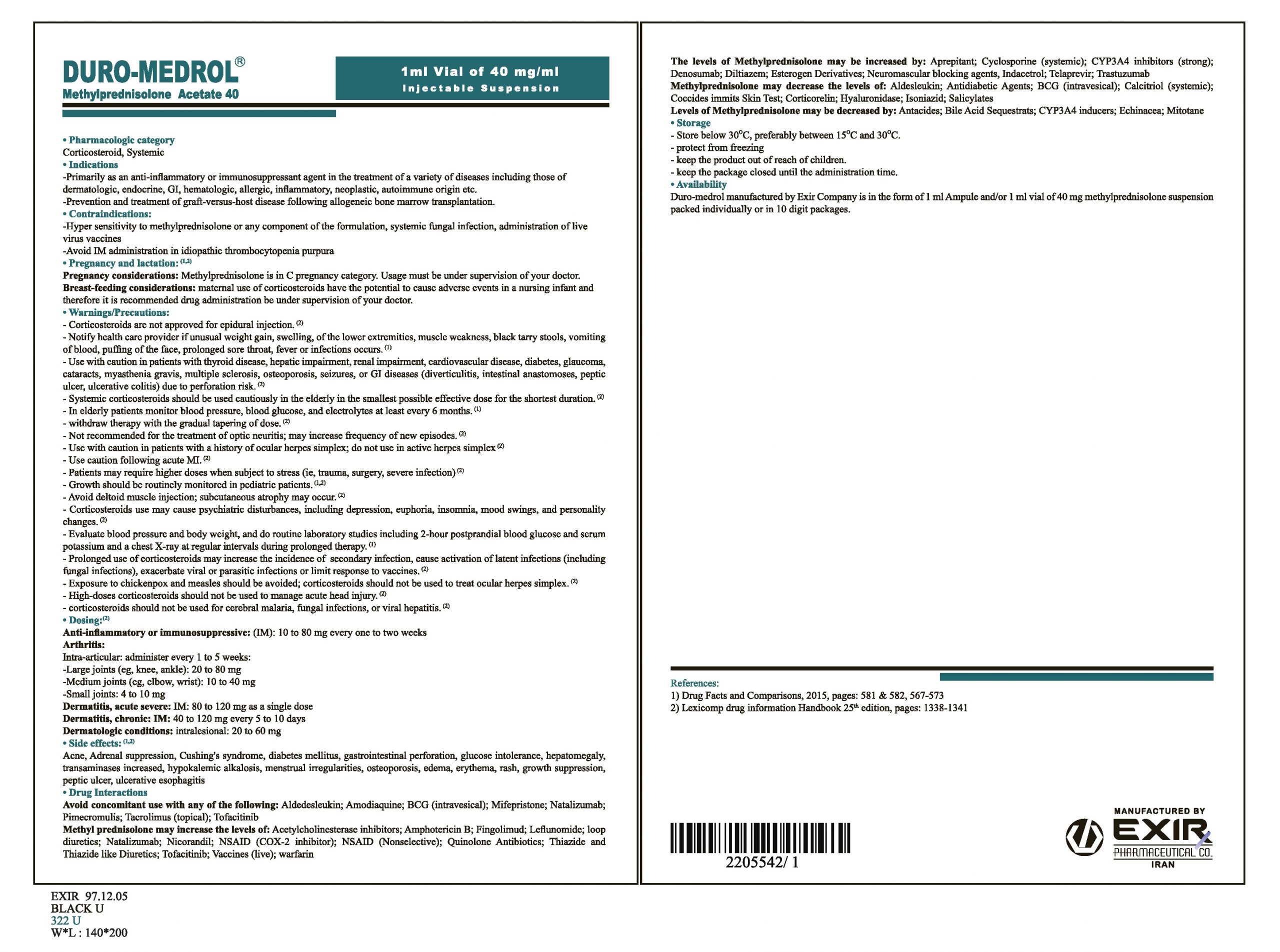DURO-MEDROL
ampoule Methylprednisolone Acetate 40mg/ml (1ml)

| Generic Name of Product | Brand Name | Dosage Form | Strength | Pharmacologic Group | Therapeutic Group | Unit Per Pack |
| Methylprednisolone Acetate | Duro-Medrol® | Vial | 40 mg/ml | Glucocorticoid | Corticosteroids | 1 |
Indications And Usage | Methylprednisolone is a corticosteroid medicine that prevents the release of substances in the body that cause inflammation. Methylprednisolone is used to treat many different inflammatory conditions such as arthritis, lupus, psoriasis, ulcerative colitis, allergic disorders, gland (endocrine) disorders, and conditions that affect the skin, eyes, lungs, stomach, nervous system, or blood cells. |
Administration | The initial dosage of parenterally administered methylprednisolone acetate injectable suspension will vary from 4 mg to 120 mg, depending on the specific disease entity being treated. However, in certain overwhelming, acute, life-threatening situations, administration in dosages exceeding the usual dosages may be justified and may be in multiples of the oral dosages. |
Contraindications | Methylprednisolone acetate injectable suspension is contraindicated in patients with known hypersensitivity to the product and its constituents. Intramuscular corticosteroid preparations are contraindicated for idiopathic thrombocytopenic purpura. Methylprednisolone acetate injectable suspension is contraindicated for intrathecal administration. This formulation of methylprednisolone acetate has been associated with reports of severe medical events when administered by this route. Methylprednisolone acetate injectable suspension is contraindicated in systemic fungal infections, except when administered as an intra-articular injection for localized joint conditions |
Precautions | This product, like many other corticosteroids, is sensitive to heat. Therefore, it should not be autoclaved when it is desirable to sterilize the exterior of the vial. The lowest possible dose of corticosteroid should be used to control the condition under treatment. When reduction in dosage is possible, the reduction should be gradual. Since complications of treatment with glucocorticosteroids are dependent on the size of the dose and the duration of treatment, a risk/benefit decision must be made in each individual case as to dose and duration of treatment and as to whether daily or intermittent therapy should be used. Karposi’s sarcoma has been reported to occur in patients receiving corticosteroid therapy, most often for chronic conditions. Discontinuation of corticosteroids may result in clinical improvement. |
Adverse Reactions | Allergic reactions, Blood and lymphatic system disorders, Cardiovascular, Dermatologic, Endocrine, Fluid and electrolyte disturbances, Gastrointestinal, Metabolic, Musculoskeletal, Neurologic/Psychiatric, Ophthalmic |
Pregnancy and lactation | Pregnancy: Corticosteroids should be used during pregnancy only if the potential benefit justifies the potential risk to the fetus. Infants born to mothers who have received corticosteroids during pregnancy should be carefully observed for signs of hypoadrenalism. Breastfeeding: Systemically administered corticosteroids appear in human milk and could suppress growth, interfere with endogenous corticosteroid production, or cause other untoward effects. Because of the potential for serious adverse reactions in nursing infants from corticosteroids, a decision should be made whether to discontinue nursing or discontinue the drug, taking into account the importance of the drug to the mother. |
Renal and liver Impairment | In general, dose selection for an elderly patient should be cautious, usually starting at the low end of the dosing range, reflecting the greater frequency of decreased hepatic, renal, or cardiac function, and of concomitant disease or other drug therapy. |
Laboratory Tests | - |

